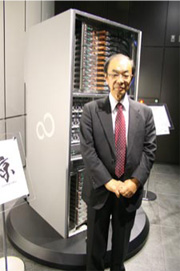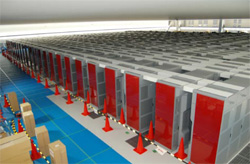Home > Highlighting JAPAN > Highlighting Japan NOVEMBER 2011 > Oh! K Computer
Highlighting JAPAN
SCIENCE
Oh! K Computer
At the 26th International Supercomputing Conference held in Hamburg, Germany, in June, the supercomputer "K computer," being jointly developed by RIKEN and Fujitsu, was awarded first place on the list of the world's best-performing computers. Osamu Sawaji of the Japan Journal reports.

Tadashi Watanabe, project leader at the Next-Generation Supercomputer R&D Center of RIKEN, stands before a rack of the K computer built for display
Credit: THE JAPAN JOURNAL
K computer's 864 racks each measure approximately 2 meters high, 1 meter deep and 80 centimeters wide. The racks, equipped with a high-performance CPU (central processing unit), are networked with one another, enabling instantaneous processing of highly complex calculations. As of June, K computer's processing speed was 8.162 petaflops [1 petaflop is the capacity to run 1 quadrillion (1015) floating point operations in a second], achieved with the 672 modules at that time. In October, K computer achieved 10 petaflops with all 864 racks: the ability to perform 10 quadrillion (1016) calculations in just one second. The name K comes from the Japanese kanji character 京 (kei), representing 1016. AICS is currently developing software targeting the official beginning of its shared use in November 2012.
"Supercomputers today are indispensable to research and development in a variety of fields, including science and manufacturing," says Tadashi Watanabe, project leader at the Next-Generation Supercomputer R&D Center of RIKEN that worked on developing K computer. "Supercomputers are extremely important for a country's infrastructure. That's why Japan and countries such as the United States, China, France and Russia are competing in their development."
Watanabe joined the development of K computer after working on development in 2002–2004 of the Earth Simulator, a supercomputer located in Yokohama, Kanagawa Prefecture, which boasted the world's fastest calculating speed at that time.

K computer, on the third floor of the RIKEN Advanced Institute for Computational Science (AICS), Kobe, Hyogo Prefecture. There are now 864 racks networked here.
Credit: COURTESY OF RIKEN
"When predicting climate change, the finer the mesh is, the more accurate the calculation becomes, but you also need a supercomputer and processing capacity in accordance with the finer mesh," says Watanabe. "K computer allows for greater accuracy in climate change simulations."
The Earth Simulator calculated climatic change based on a mesh of about 10 square kilometers; K computer uses a finer mesh of within a square kilometer. This should allow K computer to play a role not only in predicting global climate change but also in forecasting local rainstorms seen frequently in Japanese cities in recent years.
Contributing to Medical and Manufacturing Fields
Bodies involved in the life science and nanotechnology research fields are now starting to use K computer. From next year, K computer will be used in what the government designates as strategic fields for next-generation supercomputer use: life science/medical, new materials and energy creation, global change prediction, industrial innovation, and origin of matter and the universe.
Researchers in the medical field, for instance, can use K computer in studies of illnesses such as cancer and heart disease. The human body is composed of numerous and diverse proteins. Researchers believe that abnormal functions of proteins cause illness. Chemical substances that link with such abnormal proteins and serve curative effects could become treatments. Researchers have spent many years and enormous expense on animal and clinical tests to study curative effects and side effects, but using the K computer would enable them to calculate the composition of a chemical substance that is a potential link and run a simulation on its effects. This would shorten the time for developing treatments and reduce development costs.
Other research using K computer includes noise reduction in aircraft and other transportation equipment, performance improvements in solar cells, precision improvements in tsunami prediction, and studies on the originating process of black holes.
"Supercomputers are a necessary tool for improving people's lives," says Watanabe. "In the future we hope to make a supercomputer that has 100 times the processing capacity of K computer."
© 2009 Cabinet Office, Government of Japan






